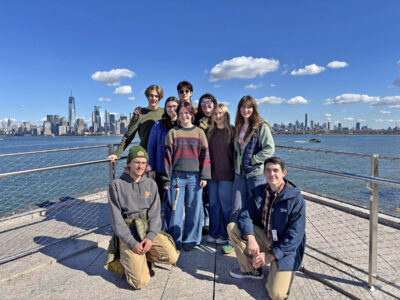‘This place is a circus’
Eight months since guard strike, state prisons remain in crisis
Everything is under control, lawyers for the state prison system told a judge two weeks ago: “At this time, general population across the state is operating as normal.”
That’s news to the nearly 1,200 men incarcerated at Auburn Correctional Facility.
Prisoners at Auburn are going stir-crazy. Classes, programs and jobs at the maximum security facility in Cayuga County are mostly canceled. Aside from meal time, people in general population units get an hour out of their cells every other day, according to two incarcerated people — the only time they’re given to shower, purchase items from the commissary and exercise or socialize in the recreation area.
“This place is a circus,” said Naythen Aubain, who’s incarcerated at Auburn.
New York’s state prison system has been in crisis since March, when a three-week guard strike ended with some 2,000 officers losing their jobs. The prison agency has struggled to staff facilities at the level it says is necessary for normal operations, leaving thousands locked in their cells for long stretches.
To many incarcerated people, dire conditions represent a new normal. Post-strike breakdowns have consumed their lives for eight months. While some facilities are running normally, others remain in states of effective lockdown.
Incarcerated people and their families want to know when conditions will improve — but the Department of Corrections and Community Supervision, which runs the state prisons, has been reluctant to offer details about what’s going on in the facilities. In April, advocates sued DOCCS, arguing that it wasn’t doing all it could to restore legally required programming and out-of-cell time. In legal filings, lawsuit exhibits and court hearings, the agency has dodged scrutiny over conditions.
Now, as the court presses for details, the agency is describing an orderly prison system unrecognizable to many of the people incarcerated within it. At a hearing last week, a state court judge asked DOCCS’ lawyers about its progress in improving operations. They claimed that things are running smoothly for a vast majority of the incarcerated population, according to a transcript.
To get a sense of life on the inside, New York Focus spoke to 10 sources: incarcerated people, their family members, advocates in touch with prisoners and watchdogs who recently visited facilities.
The sources, who represent six of the state’s 42 prisons, describe conditions that vary widely from facility to facility. Some incarcerated people have access to all of their usual group programs, while some get only worksheets in their cells. Some work jobs, while others are locked in for 23 hours a day. Some have lost out on a year of college, while others have resumed coursework, and yet others have to choose between attending class and showering.
“Guys are suffering,” Aubain said.
While Auburn is barely running, another maximum security prison, western New York’s Wende Correctional Facility, is almost back to normal, said Ahmed Greene, who’s incarcerated there. Greene gets out of his cell for seven hours a day — the legally required minimum for those who aren’t in solitary confinement — during which he goes to religious services, the prison’s law library, life skills programs and school.
Greene attributes much of the smooth operations at his current facility to National Guard troops who have been deployed to the prisons since the strike. While many facilities haven’t let the troops interact with the incarcerated population without guards present, Wende administration has them patrolling housing units and escorting prisoners to and from programs, relieving staffing pressure, Greene said.
Greene recently transferred to Wende from Five Points Correctional Facility, in the Finger Lakes region. The difference was profound, he said, as incarcerated people at Five Points are mostly confined to their cells. Tree Pryor, who’s currently at Five Points, said that staff let people out to work jobs, like serving food in the mess hall. Otherwise, programs are canceled and people are mostly locked in.
State Senator Julia Salazar, who heads her chamber’s corrections committee, recently visited Five Points. She said the facility is keeping people locked in and offering programming “cell-side” — meaning that, instead of attending congregate programs, like life skills or anger management classes, prisoners are given worksheets to complete in their cells.
That’s a stark contrast to another prison Salzar recently visited. Cayuga Correctional Facility, half an hour from locked down Auburn, is running more like Wende, with programs, jobs, and classes operating much like normal, she said. The smooth operations are particularly striking given that Cayuga is operating with one of the prison system’s worst staffing deficits: As of July, the latest date for which system-wide data is available, Cayuga had 44% of its corrections officer jobs vacant.
“What this demonstrates to me is that, when they have the will to do this, they can do it, rather than use low staffing levels to avoid complying with the law and providing incarcerated individuals with the programming and services that they need,” Salazar said.
In a statement, DOCC said that “facilities have been resuming programming as staffing levels permit toward the goal of full resumption of pre-job action programming.”
Security levels could have something to do with Cayuga’s success. It’s medium security, and thus has looser regulations on how many guards are needed to patrol, supervise, and escort the incarcerated population, explained Jennifer Scaife, head of the Correctional Association of New York, a nonprofit oversight organization.
Scaife also recently visited Five Points. In addition to being a maximum security facility, it houses a high number of mental health patients, further increasing its staff needs, she explained.
According to Salazar, Five Points’s large mental health population makes it all the more urgent to restore normal operations. Lock-ins exacerbate the stress that can lead to violence, she argued.
“This is a population that needs and deserves to experience the health benefits of in-person programming,” she said. “We’re not going to succeed in reducing anti-social behavior if we fail to offer programming in a congregate setting that enables incarcerated individuals to communicate with other people.”
Greene agreed that the lack of movement at Five Points has contributed to rising tension and violence. doccs transferred him from the facility after a group of incarcerated men attacked him and his cell mate, he said, stabbing and scratching him around the neck.
“I knew that Five Points would blow up,” he said.
Adding to frustrations at Five Points is the repeated cancellation of college courses. Throughout most of the prison system, incarcerated students were able to resume classes in August for the first time since the strike; at Five Points and Auburn correctional facilities, they’ll have to wait until spring 2026, DOCCS told New York Focus.
For some, the return of classes comes with harsh tradeoffs. Joseph Desmond is enrolled in a college program at Sing Sing Correctional Facility — but because the prison is still limiting operations, he’s missing everything else. Outside of his morning and afternoon classes, Desmond and the rest of the incarcerated population are locked in their cells. His prison job and outdoor recreation are scheduled during class time, he said, and Saturday is the only day he can shower without missing class.
At Sing Sing, how much time you get out of your cell depends on what programs you’re in and jobs you work, confirmed Katie Schaffer, who’s in touch with incarcerated people there as director of advocacy and organizing at the Center for Community Alternatives.
Caroline Hansen, whose husband is incarcerated at nearby Eastern Correctional Facility, reported much the same. Staff often let incarcerated people out of their cells late and lock them in early, and lock them in for longer stretches in the middle of the day, she said. Sometimes guards will call in sick and induce a longer lockdown.
The default is lock-in, said Desmond. “Because of the strike, it’s like, ‘Oh yeah, we’re short of staff, we just can’t do it,'” he said.
“It’s a complete shit show,” Desmond said.
——
This story originally appeared in New York Focus, a non-profit news publication investigating how power works in New York state. Sign up for their newsletter at https://tinyurl.com/368trn9p.



